Starboard Ace Air Inflatable Wing Foilboard Review
It's Wing Wednesday, and today Tucker's got an inflatable foilboard, the 2024 Starboard Ace Air. It's got some cool things going on that make it stand out in the inflatable foilboard crowd, and we'll go over those features and then follow up with a review of Tucker's time with it on the water. Even though the board is a downwind SUP shape, the review will focus on the board as a wingboard since Tucker is the first to admit he's not much of a paddleboarder, but the features will apply to both disciplines.
The Starboard Ace Air includes a nice bag, footstraps, a coil leash, and a pump. (Though Tucker recommends upgrading your session with the rechargeable Ride Engine Air Box. Why give yourself a workout before you even hit the water??) The board packs down into a fairly compact package that's perfect for people living in an apartment with limited storage space, who have a small car, who travel and need a packable board, or even for those looking for something they can't ding. It's even got the potential to be a one-board quiver, saving you even more space. Most riders can take this board anywhere and be happy.

Shape
Tucker got about 20 hours on the 6'10" x 21" 100L Ace Air, and he's pretty amped on it. Its long, narrow shape makes it ideal for both downwind paddling and light wind winging. It also increases its efficiency as an inflatable. Inflatables don't have the ability to have as complex a shape as hardboards, so they inherently tend to have more drag, and this shape helps you regain a bit of the board speed you'd normally lose with other inflatable shapes in this same volume. This means you can take off in less wind and smaller foils, making it ideal as a light wind wing foilboard. That's one reason a lot of wingers are choosing this board for travel.

There is a bit more rocker in the nose and tail, and that's helpful for winging because it helps the board rock off the water. A long board can be a little sticky on the water, and this rockered shape helps you break that suction and get up on foil.
In the middle of the board is a foam rail along each side. These are nice to grab onto when you're getting up on the board, and they're also helpful to keep your legs from slipping off the sides when you're on your knees. When you're riding a larger foil, it gives you a tactile reference to the edge of the board as well as some leverage over the rail when you're turning. If you are using the board for downwind paddleboarding, it gives you a comfortable spot to put your feet while you're in a forward-facing paddle stance.
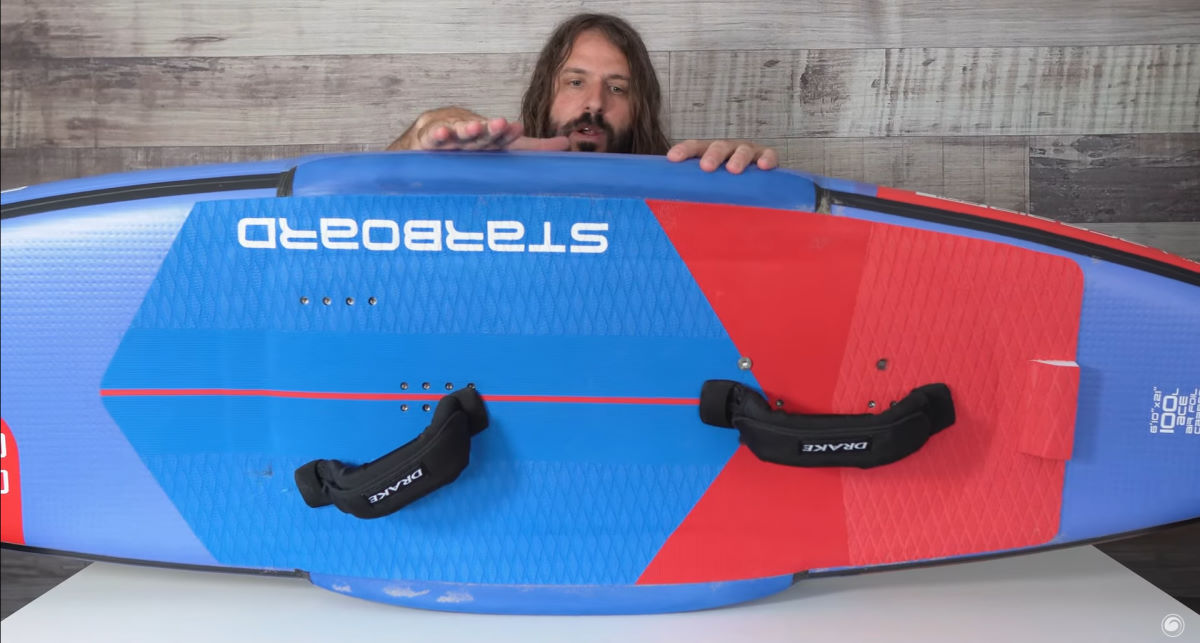
Carbon Riding Plate
The feature that people are probably most stoked about is the carbon riding plate. The rectangular area that's raised up a third of an inch or so underneath the traction pad is a hard carbon plate. Your foil mounts to the bottom of this plate, and then you stand on it, so it feels more like a hardboard than other inflatables. It's as if there's a tiny tray board surrounded by an inflatable board to give you the volume, stability, and planability you need to get going in light winds or when you're downwinding. The direct response you get from your foil lets you be so much more in tune with it; almost more than many hardboards since there isn't four inches of foam between the foil and your feet. Thanks to the carbon plate, there's only half an inch between the top of the foil and the bottoms of your feet.
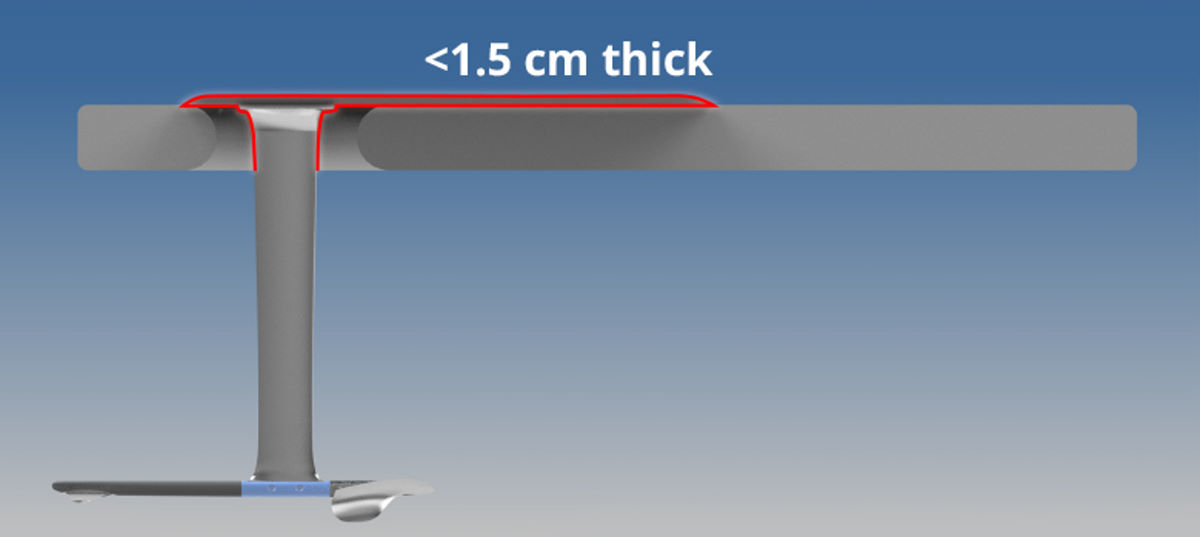
It's impressive that you can get that level of responsiveness and performance out of an inflatable board. That's normally a sacrifice you have to make to get the benefits of portability. So how did Starboard design an inflatable to let you stand on the same thin plate that your mast is mounted to?
The bottom of the board has a drop deck, with the foil mounted up through the deck to the top of the board. This does create a large hole, but the board comes supplied with a foam insert to fill that space to keep it from creating drag. Before inflating the board, you'll attach your foil and then position the foam insert. Once the board is pumped up, it'll lock that insert into place so it can't come out. However, it does have a leash that you can attach to the bottom handle for a little extra security if you'd like.
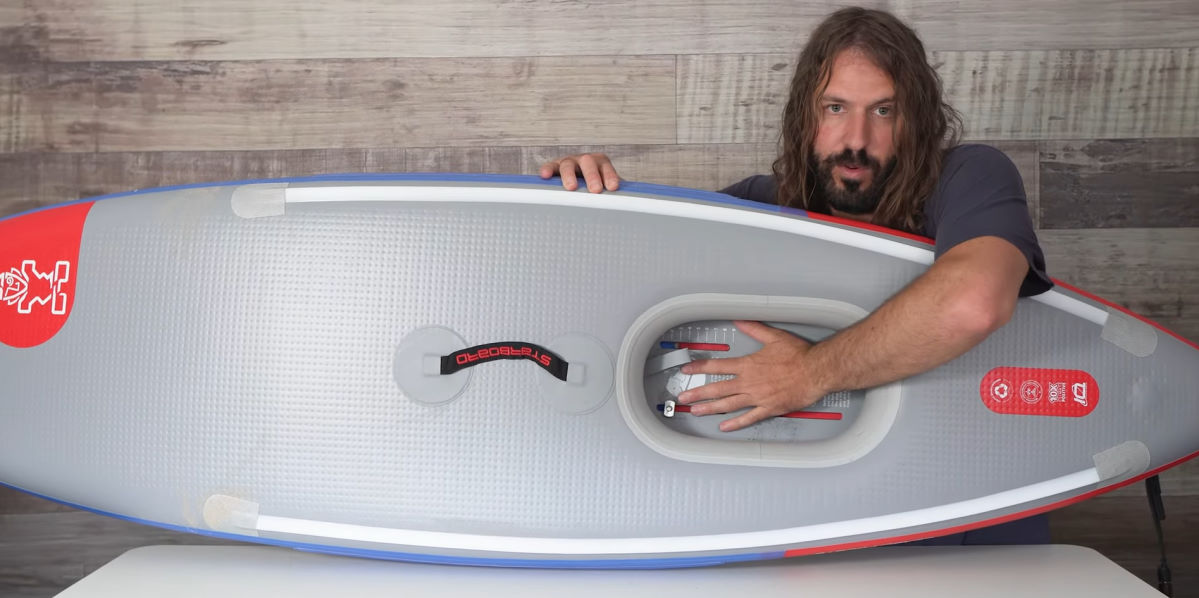
You will need to use a plate foil with this board; a Tuttle mount won't work. The track has a standard 90mm spacing, which will give you a wide variety of foil options. The track does have a bit of distance to allow for different mounting positions and patterns, though it isn't as long as many hardboards. This isn't an issue with most foils, but Armstrong foils, especially their high aspect ones, do need to be mounted further forward than this track allows. As long as you can mount your mast close to your back foot, it'll work well with this board's volume distribution. If you're riding with straps, make sure your foil will want to ride within the back strap mounting holes.
Mounting the foil is a bit different on this board vs. your typical track board since the screws don't have a track to lock into. Instead, you'll screw them in from the top side. You have a few different options for this. The easiest option is to pick up a set of Wizard Hat hardware. That has a T-nut with a bolt on it that mounts in from the top. The T-nut will lay nice and flush with the traction pad, and then the bolt secures your mast with a hex nut that has a flat or countersunk side to fit most mast plates.
You can also use your stock hardware. The board includes M6 hardware, but the slots are wide enough that you can also use M8 hardware. In most cases, you'll mount the screw head on the deck side and the T-nut on the foil side, but you can decide what works best for your setup. However you choose to mount your foil, be sure that the hardware on the deck pad doesn't have any sharp edges or rough spots to cut your foot.

Accessories
The straps also mount directly to the carbon plate, and that's a nice feature for gaining that extra leverage over the foil as you're ripping turns and jumping. Three Drake straps are included so you can have a variety of setups to fit your style. They're a longer strap, which gives you some flexibility in shifting your foot position and for getting in and out of them easily. They mount with M6 machine screws, so keep that in mind if you wish to swap these straps out for different ones so you don't ruin your board with the wrong screws.
A coil leash with a calf cuff is also included, which is what most people use for this type of board. It comes with a high pressure travel pump as well; the feet fold up to make it easy to pack. It has a standard kite hose end that will accept your adapters, so you can also use it to pump up your kite or wing as long as you keep an eye on the pressure since you can overinflate them with this pump.
Even the bag is extra nice. It's oversized for the board, so you can fit extra gear in there and travel with everything in just one bag. Tucker was able to pack the board, pump, two wings, a foil, some tools, and a wetsuit top. It all fit with no trouble. It's got backpack straps with a chest clip and waist belt, so it's comfortable if you have to hike in. At the airport, you can pull it on its three wheels. There are plenty of handles for lifting and maneuvering it, and it's padded to keep your gear safe.
All together, it's a well-thought-out package that includes everything most riders will want to get out and ride right away. The bag is overkill if you're using it for just the board, but better too big than too small. The price point is quite reasonable at $1499, considering the quality of the included accessories and the performance of the board.

Durability
The Ace Air is a bit heavier than some other inflatable boards. This is due in part to its features, and in part to the high quality construction. It's got carbon seams to make the board stiffer, and the material itself is heavy duty. It won't be as easy to damage this board or get leaks in it. It won't get sun worn as quickly, either. Tucker felt these benefits were an acceptable tradeoff for the extra weight.
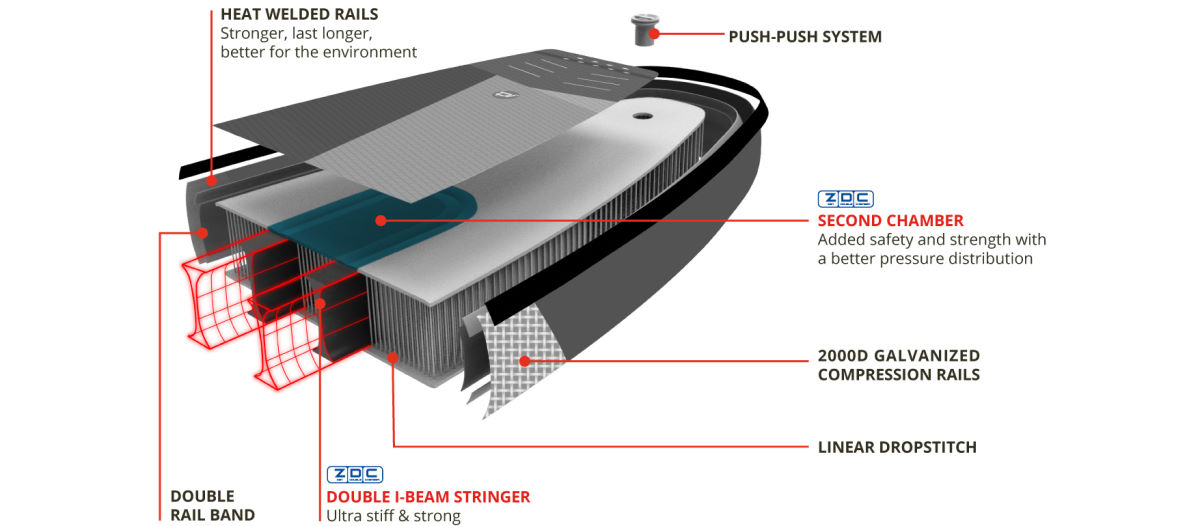
Performance
The carbon plate is the biggest part of the Ace Air's performance. It makes it feel more like a hardboard, which most people would choose over an inflatable if space and portability were not a factor. Its longer, narrower shape increases your ability to get out and up on foil in subpar winds or on smaller, high-performance foils. You'd never be able to do this with most inflatable boards unless the wind is cranking, so this is an impressive one-board/desert island quiver.
Compared to similar hardboards, the Ace Air is lighter at the ends. While it is a couple pounds heavier overall, most of that weight is toward the center of the board, so it's not going to have the swing weight of other boards. Coupled with the direct connection to the foil, it's going to be responsive and have really nice turning performance.
Past boards from Starboard used an aluminum plate, and the new carbon plate is lighter and stiffer. While the earlier boards were excellent, this does translate into an upgrade you can feel.
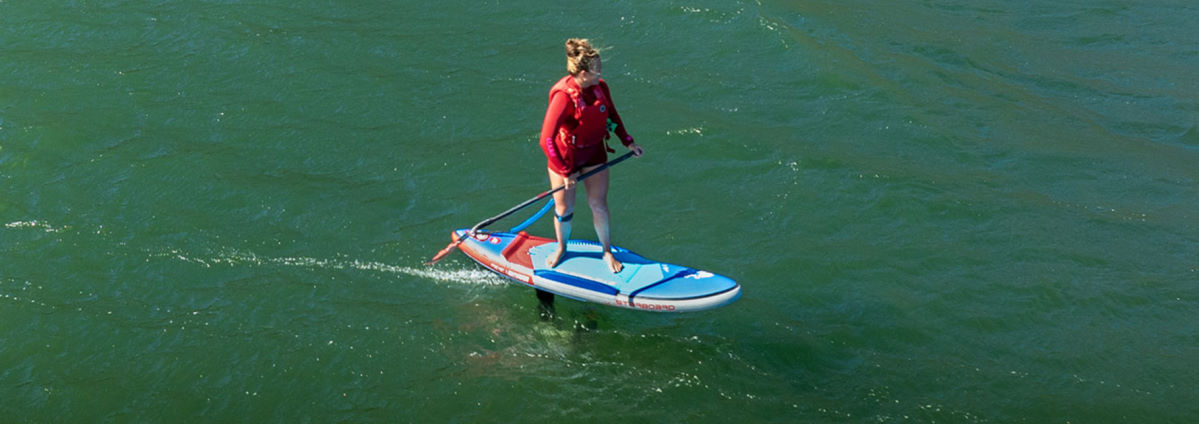
Tucker's Review
Tucker is pretty amped on the Ace Air after riding it for a while. While he expected it to be primarily a light wind board, he found it was more of an everyday driver. He was surprised at just how much performance it offered and how much fun it really was. He could do airs, ride waves, and rip at high speeds. It was an absolute blast. Even though it's a little bigger, he didn't feel like it would hold you back at all, especially if you're not a pro level rider.
Whether it was flat water or waves, 10 or 30 knots, he felt totally happy on this board. He could do it all, even up to a fairly advanced level. Of course it isn't going to have the performance of specialized hardboards, but for travel or for just getting out and enjoying the type of riding you want to do, it is going to work in a wide variety of conditions.
Having the weight toward the center of the board rather than out at the ends, along with the direct connection the carbon plate offers, made a huge difference in its turning performance. It reacted to micro adjustments, and Tucker found he could respond immediately to feedback from the foil. It wasn't at all spongy like other inflatables can be. It can also be pumped up to 18 psi, so the whole board is quite stiff, not just the area with the carbon plate. It offered a lot more performance than Tucker initially imagined it would.
That said, while the light wind performance wasn't disappointing, it didn't have quite the ability Tucker hoped it might. It's one of the most efficient inflatables and has release channels to help drop the water as you're lifting off, but at the end of the day, it's still an inflatable. It's got a rounded shape with round rails, and that's going to add some stickiness to reduce your speed a bit and hinder liftoff. It's not a board you're going to take out in 5 knots and easily get on foil like you can with a hard downwind board. However, if you take it out in 10 knots and above with a proper wing and foil, you're going to be really happy with it.
Compared to a larger, fatter hard wingboard in the same volume, Tucker feels this inflatable is just as efficient. As long as you set your expectations properly, it's going to be a great travel board for most people. Tucker was even able to get up on a 750 foil at one point, and that was in just moderately powered conditions. The trick is to use the rocker to your advantage. Since more rocker creates more drag, once you get moving a bit, use the rocker to pump it off the water with a sort of skipping motion.
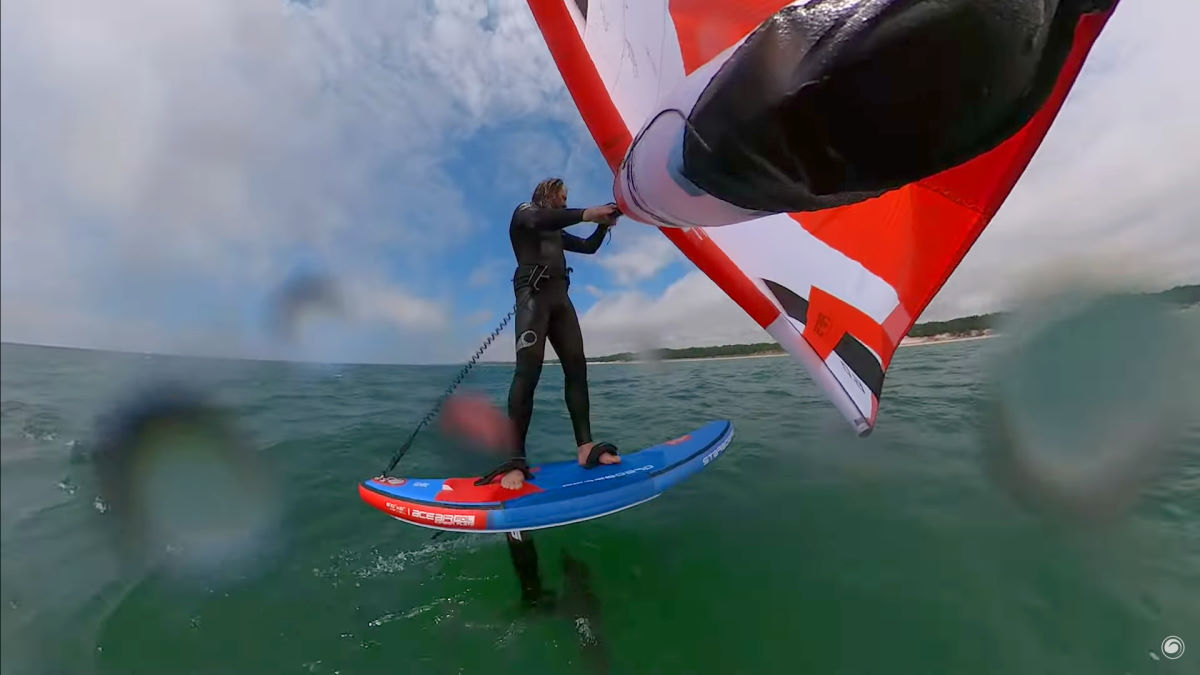
Another trick with this board is to use footstraps to gain maximum turning performance. Being a longer, inflatable board, it isn't going to leverage the foil in the same way as a hardboard would. Using straps will help you to force the board around and turn this longer board like you would a much shorter board. If you're doing airs, hard turns, or riding hard in the waves, the straps are a nice option, even when you would normally ride strapless. It also helps in super light wind conditions when you need to pump hard and want your feet to stay in place.
While Tucker tries to find something to nitpick about every product he reviews, he couldn't think of any way to improve this board. As long as you set your expectations for the limitations you'll get with an inflatable, he feels most riders are going to be very happy with the performance of the Ace Air.
MACkite Subscription Links:
YouTube | Instagram | Spotify Oddcasts
Contact MACkite Below:
800.622.4655 | Kiteboarder@MACkite.com | LIVE Chat Messenger

Recent Posts
-
2025 F-One Plume K-Wing On-Water Review | Between a Kite and a Wing Place?
Tucker's back with a review for the 2025 F-One Plume. It's a... well, he's not quite sure what t …5th May 2025 -
2025 KT Ginxu Super K Review | Why This Isn't Last Year's Board
Mid-length, or "midi" boards, have gained a lot of traction in the past couple years. They're ve …1st May 2025 -
Light Wind Kiteboarding Magic? The Reedin WhisperModel Might Be the Answer
Jeff from MACkite had a chance to meet up with Kevin Langeree of Reedin in Cape Town, South Afri …22nd Apr 2025




